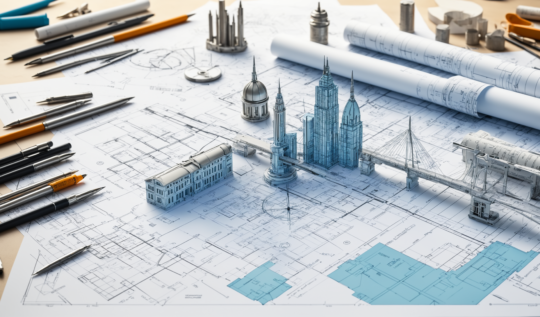What Does an Architect Really Do? Beyond Pretty Drawings
When people think of architects, they often picture someone hunched over a drafting table, sketching fancy designs on blue paper. While creativity is certainly part of the job, the truth is that architects do so much more. They play a central role in ensuring that buildings are not only visually appealing but also functional, safe, and compliant with countless regulations. In fact, architects are the glue that holds a construction project together, from the first concept sketch to the final walkthrough.
What many people don’t realize is that becoming an architect involves years of training and ongoing education. Architects must not only earn their professional degree and complete rigorous licensure exams but also register separately in every state where they submit work. Additionally, they’re required to participate in continuing education to stay up-to-date on new technologies, materials, and building codes, ensuring they deliver cutting-edge designs that meet today’s standards.
Let’s explore the many hats an architect wears and uncover just how much they contribute to the success of a project.
The Architect as a Designer
At its core, architecture is about design—but it’s more than making things look nice. Architects are tasked with designing buildings that are both beautiful and highly functional. They carefully consider the purpose of the structure—whether it’s a school, hospital, office, or home—and program the layout to maximize efficiency and usability.
For instance, in a hospital, the design must support patient care by minimizing walking distances for staff and creating calm, healing environments for patients. Similarly, a school needs classrooms that adapt to different teaching methods and communal areas that foster collaboration. Architects use their expertise to strike a balance between aesthetics and practicality, ensuring the building works seamlessly for its intended purpose.
Today’s architects also rely on tools like 3D renderings and virtual reality to bring their designs to life. These visualizations help clients and stakeholders see exactly how a space will look and function before construction even begins.
The Architect as a Structural and Safety Expert
Beyond design, architects are deeply involved in ensuring that buildings are structurally sound and safe. They work closely with structural engineers to guarantee that the building can withstand environmental forces like wind, earthquakes, or heavy snow loads. Additionally, architects incorporate critical safety features such as fire exits, sprinkler systems, and accessibility for people with disabilities.
What makes this even more impressive is the fact that architects must tailor their expertise to the specific codes and regulations of each state where they work. For example, an architect designing a project in California must account for stringent earthquake standards, while a project in Florida might require enhanced hurricane resistance. This requires not only technical expertise but also the flexibility to adapt to different regulatory environments.
Architects must also ensure that their designs comply with building codes, zoning laws, and environmental regulations. Their expertise helps prevent costly mistakes or delays that can occur if a design doesn’t meet these standards.
The Architect as a Coordinator
One of the architect’s most critical roles is as a coordinator. They are the central hub, bringing together various experts to create a cohesive and functional building. Architects work with:
- Structural Engineers: To ensure the building is stable and safe.
- Mechanical, Electrical, and Plumbing (MEP) Engineers: To integrate essential systems like HVAC, lighting, and water supply.
- Contractors: To ensure the design is executed properly on-site.
- Landscape Architects: To incorporate outdoor elements like green spaces and pathways.
Architects act as a bridge between these specialists, ensuring that every detail comes together in harmony.
The Architect as a Legal and Regulatory Guide
Building a structure involves a complex web of legal and regulatory requirements, and architects are well-versed in navigating this process. They handle tasks such as:
- Preparing and submitting detailed plans to local authorities.
- Ensuring compliance with zoning laws and building codes.
- Obtaining permits for construction.
Additionally, architects are required to stay current with annual professional development. Many states mandate that architects complete a set number of continuing education hours each year to maintain their licensure. This ongoing training ensures they stay up-to-date on advancements in materials, technologies, and best practices, allowing them to offer clients innovative and compliant designs.
The Architect as a Project Manager
Once construction begins, the architect’s job is far from over. They act as the project manager, overseeing the construction process to ensure everything is built according to the approved design. Architects regularly visit the site, review contractor work, and address any issues that arise during construction.
By acting as a liaison between the client and the construction team, architects ensure that the project stays on budget and on schedule. Their involvement helps maintain quality control, preventing costly errors or deviations from the original vision.
The Architect as a Financial Sign-Off Authority
In many cases, architects are also responsible for signing off on contractor work so that banks or lenders can release funds for the next phase of the project. This role adds a layer of accountability, ensuring that contractors meet the required standards before payments are made. By acting as an impartial authority, architects protect the client’s investment and ensure the project progresses smoothly.
The Value of an Architect: More Than You Think
As you can see, architects do far more than just draw pretty pictures. They are designers, safety experts, coordinators, project managers, and financial stewards—all rolled into one. Their expertise not only saves clients time and money but also ensures that the final building is functional, safe, and aligned with the client’s vision.
By hiring an architect, you gain a partner who can guide you through every step of the process, from concept to completion. Their ability to balance creativity, technical skill, and regulatory knowledge is what sets them apart and makes them an invaluable asset to any project.
Final Thoughts
The next time you see an architect hunched over a blueprint or working on a CAD drawing, remember that they’re doing much more than creating pretty buildings. They’re crafting the foundation of a building’s success, bringing together expertise from countless disciplines to create something extraordinary.
At UNITE – Architecture & Beyond, we take pride in wearing all these hats and more. If you’re planning a project and want to ensure it’s designed and built to perfection, contact us today to see how we can help bring your vision to life.





